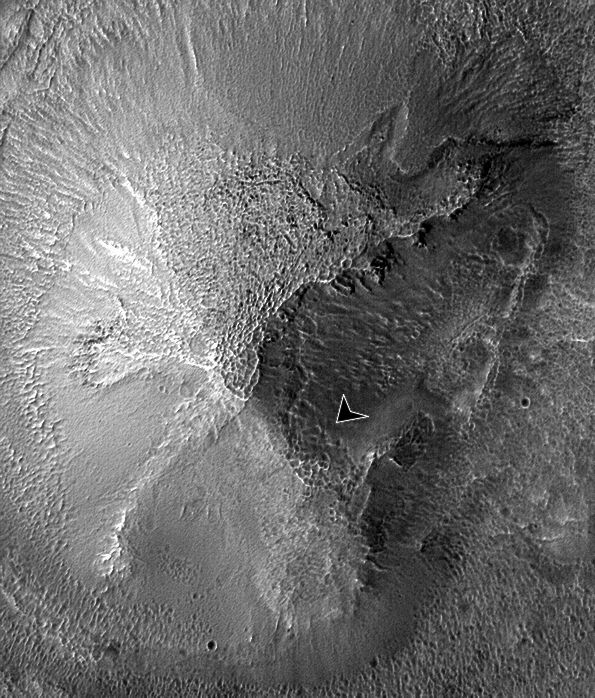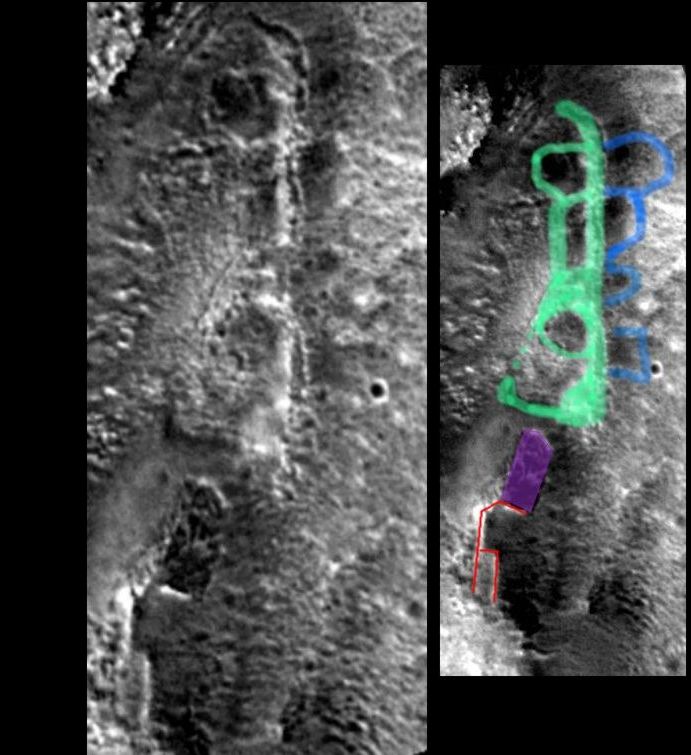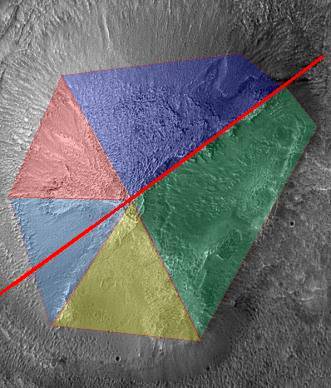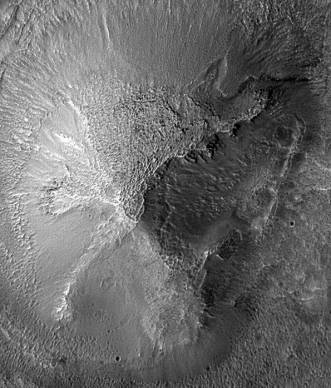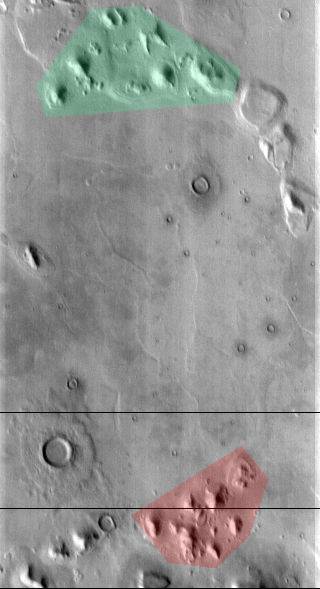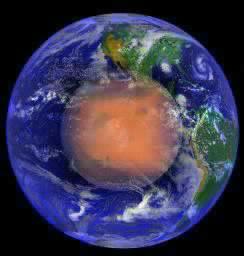 Cydonia Quest C Image Enhancements C c The West Mound in SuperBowl City Note: This website is best viewed at a screen resolution of 800 x 600 pixels. Higher resolution settings will reduce both the size and quality of the images displayed, thus leading to a loss of detail. For tips on adjusting screen resolution and other ways of improving the screen appearance of the internet click this "stargate" µµµ. Since SuperBowl City was first noticed in a low resolution image from the Mars Odyssey spacecraft (see µµµ) it has been a priority area for study by this website. Unfortunately, the coverage of SuperBowl City by the high resolution camera of the Mars Global Surveyor (MGS) spacecraft has, until recently, been confined to one narrow image strip. I had therefore put in requests for the whole of this area to be imaged by the MGS under MSSS's Public Target Request Programme. The November 2004 image releases under this programme included one titled "Buttes & Knobs in Cydonia", (see µµµ). On opening the wide angle context picture for this image it was discovered that it included the western-most mound in SuperBowl City. This "West Mound" had fortunately been imaged at a much higher resolution than the earlier image of the "SuperBowl" mound and showed many features consistent with the arcology theory. The eastern flank of this arcology candidate appeared to have caved into a hollow interior leaving ruin like anomalies around the southern and eastern sides of the resulting depression.
|
Not the least of these anomalies is the room-like honeycombing on the eastern edge of the hollow, which is arrowed in the full resolution, enhanced image below. The West Mound is about two thirds of a mile across. C ccccccccc As always with these outsized images the reader is advised to use the "View" then "Full Screen" options from the menu bar at the top of their browser screens to see more of the image clearly. c In addition to this artificial looking honeycombing, the whole eastern edge of the hollow suggests, in its arrangement of walls and depressions, the remains of architectural features on a larger scale. The Cydonia Quest model for most Cydonia arcologies is that the main zones of living space are separated by extremely thick retaining walls that radiate outwards from the arcology's core. This hypothesis proposes that when a zone of living space collapses inwards, the stump of the arcology's shell is often left behind as a low wall that marks the former boundary of the arcology. In many examples of arcology candidates at Cydonia the hollow on the internal side of the wall is lower than ground level in the surrounding landscape. This "walled moat" effect can be explained by the above ground parts of these arcologies being swallowed up by the subterranean levels as they crashed down into the basement. In the case of the West Mound in SuperBowl City the collapse of the theoretical living zone on the eastern side has exposed much more of the internal architecture than in any other ruined arcology candidate imaged before 2004. This is shown in the following two times enlargement of these features, which is accompanied by a diagram with schematic annotation showing the main architectural looking patterns. C
As always with these outsized images the reader is advised to use the "View" then "Full Screen" options from the menu bar at the top of their browser screens to see more of the image clearly. c One thing of interest in the enlargement is that the outer remnant of wall (which is all that remains of the former arcology shell) has a fissure running the length of it. It seems to be a double skinned wall like the hull of some ships. Secondly, there is another arrangement of ruined walls, interior to this outer wall, that surround subsidence hollows. The outlines of the ruined outer and inner walls/hollows are outlined in green in the diagram above. A very unusual feature of the West Mound is that there are subsidence hollows on the exterior side of the main wall - making it moated on both sides. The outlines of these hollows are shown in blue. It can be seen that on the northern part of the main wall there is an approximate symmetry between the hollows on either side of it. First, two roughly circular hollows of similar size mirror each other on either side of the wall. Moving south, two oblong hollows mirror each other from either side. This rough mirror symmetry in the crumbling piles of rubble suggests that artificiality rather than geology is at the root of these walls and hollows.
|
Another area of interest is to be found in the feature coloured in purple. An almost oblong shaped area on the flank of the West Mound is eroding downwards in a fretwork fashion. Could this be the roof of a hidden chamber beginning to be eroded through? Maybe in 10,000 years time this feature may end up as a walled hollow like those lined up to the north of it. To the south of this some linear features are annotated in red. A speculative reconstruction of the West Mound's original shape. Some arcology candidates at Cydonia appear to be the result of the tunnelling out of naturally occurring hills. If this is the case with the West Mound, then the collapsed east side may be the whole of the arcology. However, after using clues from ridge lines, corners and edges the following rough-and-ready reconstruction was made. It seems to suggest that the West Mound was originally an elongated, five faceted pyramid. A line extended through the division between the two largest facets (shown in red) further suggests that the West Mound might have been mirrored around a line of symmetry. If this is a correct interpretation then the whole of this mound is artificial and other undisturbed chambers may exist within its bulk. If artificiality at Cydonia is eventually proven then future "Raiders of the Lost Arcologies" looking for undamaged hi-tech artefacts would be best advised to tunnel into the northern facet (coloured in the darker blue). This side of the West Mound shows no sign of collapse. C cccccccccccccccccccccccccccccc cccccccccccccccccccccccccccccc
c The following illustration shows Richard Hoagland's "Cydonia City" mounds shaded in red and the "SuperBowl City" mounds to the north shaded green. West Mound in SuperBowl City is the one at the extreme left hand side of the green shaded area. C ccccccccccccccccccccccccccccccc C µ Return to the Enhancements page µ Return to the main Mars page
|
